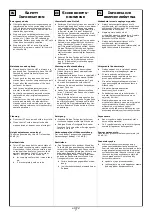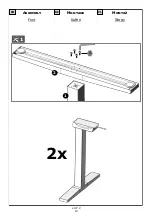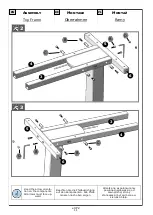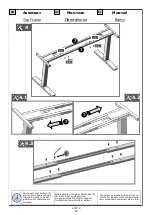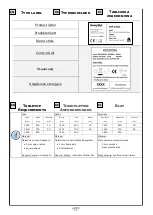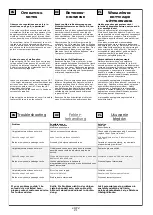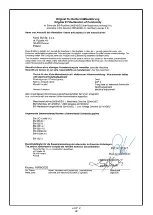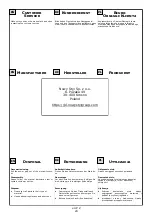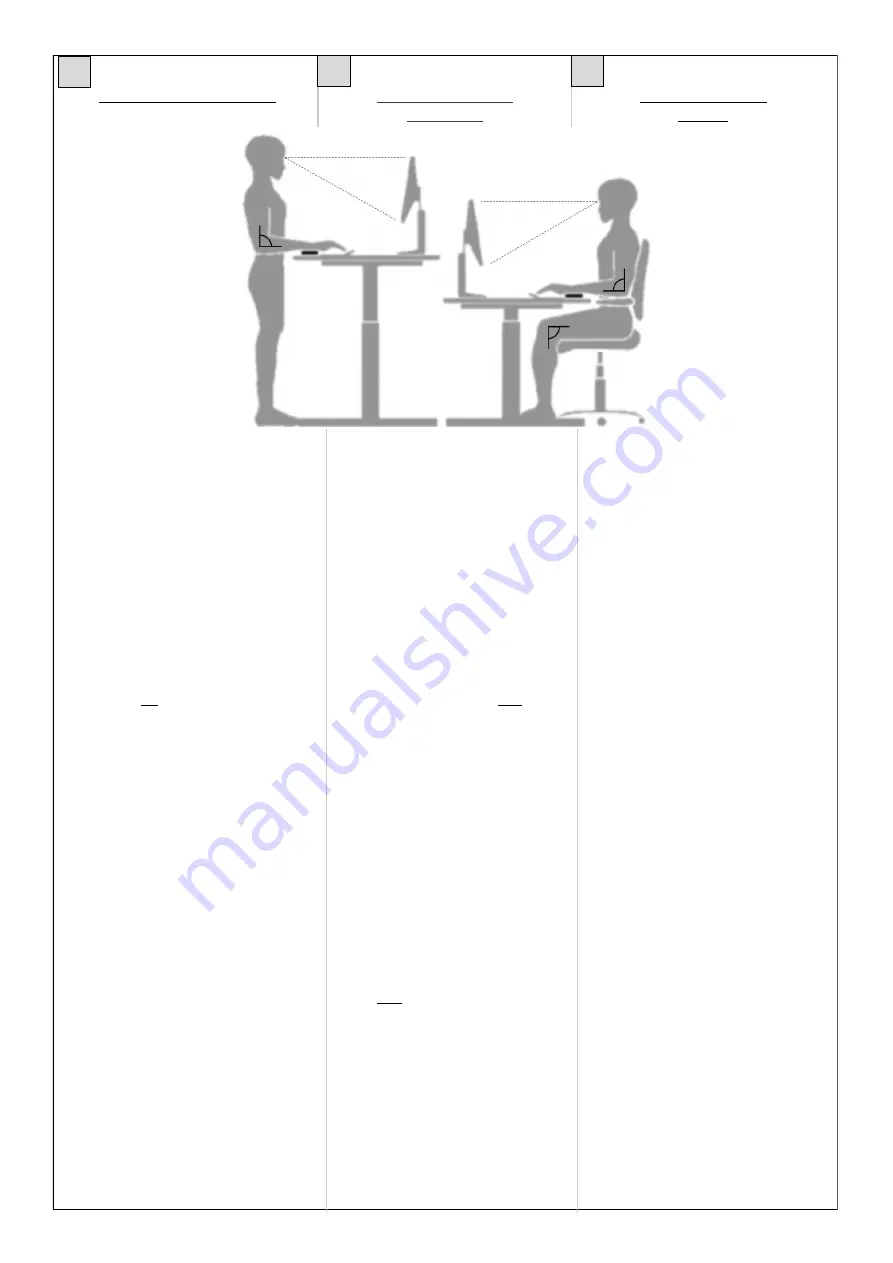
e UP 2
18
General advice
An incorrect posture can lead to injuries at joints,
bowstrings and muscles. In order to prevent this
it is necessary to adjust your office chair and
desk. Apart from the following advise you should
always prevent an uncomfortable postures. If you
feel that the following advice leads you to an
uncomfortable posture simply adapt your needs.
Change between sit/stand positions regularly
throughout your work day.
Correct height
The optimal height is always achieved by:
•
Upper body is straight, shoulders are loose
•
Upper arms point vertical towards the floor.
•
Lower arms being right angled to upper arms,
while resting on the table top.
Office Chair
•
The sitting height has to be adjusted in way
that your knee is angled by 90
-
120° when
your foot is flat on the ground.
•
Sitting properly requires that your lower back
touches the back rest. If possible align the
seating depth in order to avoid pressure from
the seat pan to your lower leg
•
Sit upright but lean back in a relaxed position.
If possible adjust the lumbar support of your
chair to your height. Adjust the back rest in a
way that pushes your upper body slightly
forward but still offering enough flexibility to
yield
movement.
•
If possible adjust the height of your armrests.
Your shoulders should be in a relaxed position
when your arms are touching the arm rest.
Desk
•
Adjust the table height after you have found
your correct sitting posture
•
Your elbows should be angled by 90
-
120°
when your arms rest on the table top. The
edge of the top should not press against your
arms.
Equipment on the desk
•
Incident light (day light or lamps) on your
monitor should approach the surface of your
screen by an angle of 90°.
•
The height of your monitor should be adjusted
in way that enables you to look slightly down-
ward while focusing the centre of your screen.
•
Please keep a distance of 60
-
70 cm from your
screen
•
A careful posture for your wrists can be
achieved by a flat narrowed keyboard.
Please heed the advice in the manuals of
your further (ergonomical) equipment.
Allgemeiner Hinweis
Die falsche Körperhaltung kann zu gesundheit-
lichen Schäden an Gelenken, Sehnen und
Muskeln führen. Um dies zu vermeiden, müs-
sen Schreibtisch und Bürostuhl eingestellt
werden. Unabhängig von den nachfolgenden
Hinweisen ist eine unbequeme Haltung zu
vermeiden. Wechseln Sie im Verlauf der Ar-
beitszeit mehrfach zwischen Steh
-
Sitz Positio-
nen.
Richtige Arbeitshöhe
Die optimale Arbeitshöhe wird stets auf diese
Weise eingestellt:
•
Der Oberkörper ist gerade, die Schultern
locker.
•
Oberarme fallen senkrecht nach unten
•
Unterarme sollen im rechten Winkel zum
Oberarm sein und auf der Tischplatte auf-
liegen.
Bürostuhl
•
Stellen sie die Sitzhöhe so ein, dass ihre
Knie jeweils einen Winkel von 90° bis 120°
haben, wenn ihre Füße dabei flach auf dem
Boden stehen.
•
Eine optimale Sitzhaltung ergibt sich, wenn
ihr Gesäß an der Rückenlehne anliegt. Stel-
len sie die Sitztiefe so ein, dass die Kante
der Sitzfläche nicht gegen ihre Unterschen-
kel drückt.
•
Sitzen sie aufrecht und lehnen sie sich
dabei entspannt gegen die Rückenlehne.
Sofern möglich, stellen sie die Lordosen-
stütze des Stuhls auf Ihre Körpergröße ein.
Die Rückenlehne sollte so eingestellt wer-
den, dass ihr
Oberkörper leicht nach vorne gedrückt
wird, jedoch
flexibel ihren Bewegungen nachgeben kann.
•
Wenn möglich, stellen sie die Armlehnen so
ein, dass ihre Schultern entspannt sind,
wenn die Unterarme aufliegen.
Schreibtisch
•
Passen sie die Schreibtischhöhe erst dann
an, wenn sie die korrekte Sitzposition ge-
funden haben.
•
Ihre Ellenbogen sollten einen Winkel von
90°
-
120° haben, wenn ihre Unterarme auf
der Tischplatte liegen. Die Tischkante darf
dabei nicht gegen ihre Unterarme drücken.
Arbeitsgeräte auf der Tischplatte
•
Einfallendes Licht auf ihren Monitor
(Fenster oder Leuchtmittel) sollte in einem
Winkel von 90° auf die Bildschirmoberflä-
che fallen.
•
Die Monitorhöhe ist so einzurichten, dass
ihr Blick zur Bildschirmmitte leicht abwärts
gerichtet ist.
•
Halten sie ca. 60
-
70 cm Distanz zu ihrem
Monitor
•
Eine schonende Handgelenkhaltung erhal-
ten sie, wenn die Tastatur möglichst flach
aufliegt
Beachten Sie die Hinweise in den Anlei-
tungen ihrer weiteren (ergonomischen)
Arbeitsgeräte.
Niewłaściwa postawa może
uszkodzić stawy, ścięgna i mięśnie. Aby
tego uniknąć, należy wyregulować biu
ko i krzesło biurowe. Należy unikać
niewygodnej pozycji niezależnie od
poniższych instrukcji. Kilka godzi
przełączaj się między pozycją stojącą
i siedzącą.
Prawidłowa wysokość robocza
Optymalną wysokość roboczą ustawia się
zawsze w następujący sposób:
•
Tułów jest prosty, ramiona luźne.
•
Ramiona opadają pionowo
•
Przedramiona powinny być ustawione pod
kątem prostym do ramienia i spoczywać
na blacie stołu.
Krzesło
•
Wysokość siedziska należy ustawić w taki
sposób, by stopy leżały płasko na podłodze, a
zgięte kolana zawsze tworzyły kąt od 90° do
120°.
•
W optymalnej pozycji siedzącej pośladki
powinny przylegać do oparcia krzesła.
Głębokość siedziska należy ustawić w taki
sposób, żeby jego krawędź nie powodowała
ucisku na podudzia.
•
Należy siedzieć w pozycji wyprostowanej,
swobodnie opierając się o oparcie. O ile to
możliwe, należy dostosować podparcie lędźwi
do wzrostu użytkownika.
•
Oparcie należy ustawić w sposób zapewniający
lekkie nachylenie tułowia ku przodowi, przy
czym powinno ono elastycznie poddawać się
ruchom użytkownika.
•
Jeśli to możliwe, podłokietniki należy ustawić
w sposób zapewniający swobodną pozycję
ramion w momencie ułożenia przedramion na
podłokietnikach.
Stanowisko Workbench
•
Wysokość stanowiska należy dostosować
dopiero po ustawieniu prawidłowej pozycji
siedzącej.
•
Po położeniu przedramion na blacie, łokcie
użytkownika powinny tworzyć kąt od 90° do
120°. Krawędź blatu nie powinna przy tym
powodować ucisku na przedramiona.
Narzędzia pracy na blacie stołu
•
Światło oświetlające monitor (światło
naturalne lub światło lampy) powinno
padać pod kątem 90°.
•
Wysokość monitora należy wyregulować w
taki sposób, by wzrok użytkownika padał
nieco poniżej środka ekranu.
•
Należy zachować odległość ok. 60
-
70 cm
od monitora.
•
Prawidłowe ułożenie nadgarstków można
uzyskać umieszczając klawiaturę możliwie
płasko na blacie.
Należy stosować się do instrukcji dla
pozostałego wyposażenia biurowego
(dotyczących ergonomii pracy).
Guide:
Ergonomic Working
Ratgeber:
Ergonomisches
Arbeiten
Wskazówki:
Ergonomiczna
praca
EN
DE
PL
Summary of Contents for eUP 2
Page 2: ...e UP 2 2 ...
Page 10: ...e UP 2 10 1 Assembly Feet Montage Kufen Montaż Stopy EN DE PL 1 2 A 2x ...
Page 22: ...e UP 2 22 ...
Page 23: ...e UP 2 23 ...




